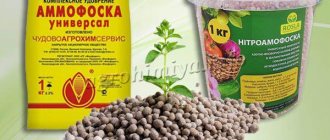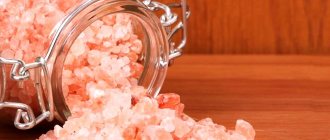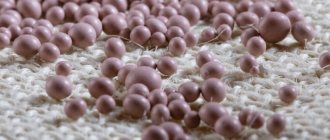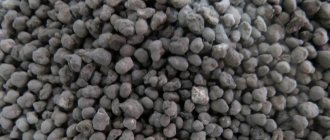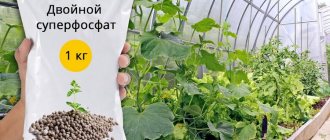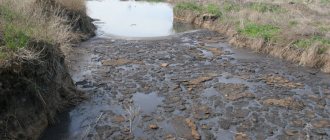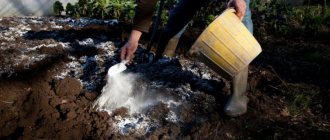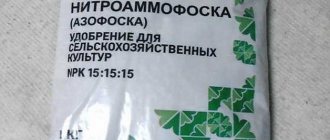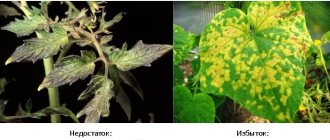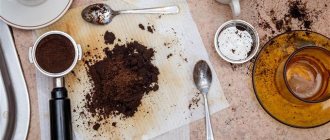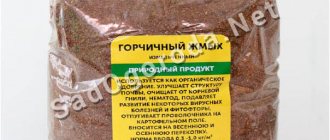Ammonium nitrate (NH4NO3, other names - ammonium nitrate, ammonium nitrate, ammonium salt of nitric acid). The main active ingredient is nitrogen. It is contained in the fertilizer from 26% (low grades) to 34.4% (high grades). The second macroelement of classical ammonium nitrate is sulfur, which this agrochemical contains from 3 to 14%.
chemical formula of ammonium nitrate
Ammonium nitrate, along with urea (urea), is an ideal fertilizer for spring use. At the start of their development, plants do not hesitate to consume nitrogen in huge doses, and in tandem with sulfur this element is absorbed especially well and quickly. This property explains its presence in the composition of the agrochemical, because sulfur itself is not the most nutritious substance for plant organisms.
Physiologically, this is an acidic fertilizer, which, at the same time, does not acidify the soil with a normal pH reaction. But if you use ammonium nitrate on acidic soils, then in parallel it is necessary to add calcium carbonate, in a proportion of 0.75 g per 1 g of nitrate.
Ammonium nitrate is needed, first of all, to actively saturate plants with nitrogen. This is its main task, which is helped by the additional macro- and microelements included in the composition.
Price issue
Ammonium nitrate is a very economically advantageous agrochemical. Its price is about 20-25 rubles per kg. If we take into account that the rate of application of this mineral fertilizer is, on average, about 10-20 g/sq. m., then for one hundred square meters (100 sq. m.), it is necessary to spend only 1 kg of fertilizer.
Even taking into account the fact that the use of ammonium nitrate is not very rational without other mineral fertilizers, fertilizing with it is very profitable.
You can buy ammonium nitrate either in bulk or in packaged form. Very often in stores selling products for gardeners, you can find its varieties with various additives. They have a narrower application, but at the same time, they solve specific problems better than the main fertilizer with a wide range of uses.
Use as nitrogen fertilizer for plants
The range of applications of this fertilizer is wide:
- for feeding flowers, various shrubs,
- fertilize fruit trees, vegetable crops and root crops.
Plant growers often use it to obtain good seedlings. It is relevant to use even during the active growing season. In addition to vegetable growing and gardening, it is also used in indoor floriculture, combined with potassium salt. It is effective both in the summer months and during the winter dormancy period, which is its distinctive feature.
There is a requirement for the depth of application - at least 10 cm. Application measures depend directly on the initial composition and quality of the soil, the worse it is, the more fertilizing will be required, 40-50 g per 1 sq. m. For nutritious soil, no more than 25 g per 1 sq m
The application rate also differs depending on the type and variety of the plant. Vegetable crops are fed at least twice: before the first buds appear and after the fruits appear, 5-10 g per 1 sq. m.
Root crops require 6-7 g of the substance per 1 sq. m; for them, granular fertilizer is distributed in small ditches between the rows to a depth of 3-4 cm three weeks after the appearance of the first shoots. Fruit trees need a larger amount, and it is applied with the blossoming foliage. 30 g of the substance per 10 liters of water are thoroughly mixed and poured under the root. During the period of ripening of berries on bushes, they are fed in the proportion: 50 g of dry fertilizer per 10 liters of water. It is advisable to carry out such feeding systematically, at least twice a month.
It is worth noting that you must adhere to some rules for using fertilizer:
- Shared use with organic substances: peat, straw, sawdust, chalk, dolomite. This can lead to the most unfavorable consequences: during reactions between substances, they can ignite.
- Indoor plants are fed until the first buds appear.
- Decorative - deciduous trees need to be fertilized during the period of active growth of green mass.
- An excess of fertilizers affects plants much worse than a lack of certain substances, and this must always be taken into account and the norms and timing of application must be observed.
After entering the soil, nitrogen mineralized by microorganisms from ammonium nitrate begins to be quickly absorbed by plants. Each time a substance is added, it is necessary to water the crop abundantly so that the saltpeter dissolves better and reactions with the absorbing soil complex begin.
If the soil lacks calcium, after fertilizing with ammonium nitrate, temporary acidification of the soil occurs:
- On soils with high acidity, acidification can be reduced and the quality of the soil can be improved using liming;
- Soddy-podzolic soils require the application of neutralized or lime-ammonium nitrate.
- Due to the content of bases, sierozems and chernozems do not become acidified. For such types of soil, ammonium nitrate is one of the best and most effective fertilizers.
Types of ammonium nitrate
Almost always this fertilizer is produced using additives of various elements. The presence of such a large assortment is explained by the wide geography of application of ammonium nitrate, and an attempt to adapt to the needs of agriculture in different climatic zones.
- Simple ammonia . This type was the very first to be developed. The main idea behind it is to provide crops with powerful nitrogen nutrition. The use of ammonium nitrate in agricultural complexes of different countries has repeatedly confirmed its high efficiency as the optimal starting fertilizer for the majority of plants cultivated in the middle zone. This type of nitrate can equally replace another popular mineral supplement - carbamide (urea).
- Ammonia, grade B. Divided into varieties, first and second. Great for using and storing at home. It is sold in gardening stores and comes in convenient packaging, starting from 1 kg. Why might it be needed at home? For flowers that are sick after spending winter on the windowsill, for primary feeding of seedlings, which, in conditions of short daylight hours, vitally need nitrogen.
- Ammonium-potassium (K2NO3) . People call it “Indian saltpeter”. This species is especially effective for early spring feeding of fruit trees. It is also ideal for pre-sowing application and subsequent fertilizing for tomatoes, because potassium improves the taste of the fruit.
- Calcium-ammonium (Norwegian nitrate). It can be simple or granular. Contains calcium. Its production is regulated by TU 2181-001-77381580-2006. In addition to the main one, this agrochemical contains additional substances - potassium, calcium and magnesium. Calcium ammonium nitrate is characterized by high strength granules and does not cake during storage. The alarming thing is that it is treated with fuel oil, and this fraction lives in the soil for a very long time, causing quite significant harm to it.
Lime-ammonia grade is used to fertilize almost all crops. Does not increase soil acidity and is well absorbed. The main advantage is safety - lime-ammonium nitrate does not explode, and therefore it can be transported by any means of transport.
- Magnesium nitrate–hydrate (magnesium nitrate). The formula of this substance looks like this: Mg(NO3)2 - H2O. Used for vegetables and legumes as an additional source of magnesium.
- Calcium. Available in both dry and liquid form, which does not need to be diluted. It’s called “Ammoniated calcium nitrate solution.”
- Porous ammonium nitrate (TU 2143-635-00209023-99). But this species has never been a fertilizer, and poses a great danger. It was originally used only to create explosives.
Use of saltpeter
Ammonium nitrate is applied to the soil at different times and in different quantities. Everything depends on what crop is fertilized. How should the soil be fertilized? At what time of year will bait feeding be carried out?
You also need to consider what type of soil will be fertilized and the climatic region. Otherwise, if you uncontrollably scatter saltpeter around the garden, it will only harm the crops.
Saltpeter can be used on all soils. But you need to remember that podzolic soils produce a slight acid. Therefore, if the soils are heavy (clayey or chernozem), fertilizing is applied in early spring or late autumn.
Since nitrogen is quickly washed out by water, in regions with high humidity, ammonium nitrate must be applied to the ground both in the fall and in the spring.
Adding saltpeter to the ground
Biologists have scientifically proven that after fertilizing land plots with ammonium nitrate, the yield of vegetable and garden crops doubles.
This bait is used in granules (dry form), or in liquid form, for root feeding. Another advantage of ammonium nitrate is that it dissolves well in water.
Initially, ammonium nitrate begins to be applied during the period when shoots and greenery are formed. This time is from early spring to July. Later, fertilizer is no longer applied, as this will only slow down the ripening of the fruit. Nitrogen will stimulate the development of leaves and branches.
For those vegetable crops that can be planted in seedlings or tubers, saltpeter is added directly during planting. No more than two grams of fertilizer are added to each individual planting hole.
To prepare a liquid solution of saltpeter for feeding, you need to dilute 60-80 grams of granules in twenty liters of water. The fertilizer will dissolve instantly, so it is very convenient to use for root and foliar feeding of plants.
Before sowing the seeds of tuber crops such as beets, carrots and parsley, the soil must first be fertilized. Why add no more than 50 grams of ammonium nitrate per square meter. If the site was fertilized earlier in the spring, then the rate is halved. An excess of ammonium nitrate can burn the seed material.
When planting berry bushes and young trees, up to 20 grams of saltpeter are added per square meter of land. And not only in the planting hole, but throughout the entire area around the root and branches.
Mature trees are fed twice during the growing season. The first time during flowering, the second time in mid-summer (1 month after flowering).
Since saltpeter draws water from the rhizome, after fertilizing the crop, you need to water the area well. Otherwise, burns may appear on the roots.
Application against plant diseases
Why is ammonium nitrate so widespread in industrial farming? It not only nourishes the soil with essential macroelements, but also protects plants from a host of diseases , strengthening their immunity.
This property is especially important when there is intensive exploitation of the land or when crops from the same class are grown annually on one plot (non-compliance with crop rotation). For example, many gardeners allocate the same piece of land for potatoes in small summer cottages every year. And then they wonder why the tubers still in the soil begin to rot. Many people are familiar with this problem - you dig up a seemingly healthy bush, but the potatoes are half rotten and smell bad.
Long-term continuous cultivation of this crop in one place leads to the accumulation of pathogenic fungi in huge quantities in the upper layers of the soil. The harvest is declining. To improve the health of the soil, it is treated with various disinfectants (the most accessible solution is potassium permanganate), and ammonium nitrate is added during spring plowing , which helps strengthen the plant’s immunity from the appearance of the very first leaves. Physiologically healthy cultures deprive fungi of their “home”; the body rejects foreign microspores.
Composition and types of saltpeter
Ammonium nitrate is also called nitric acid salt or ammonium nitrate - the formula of the substance is NH4NO3. Sometimes the composition includes the trace element sulfur, which is also needed by plants. It contains from 3 to 13%.
There are several types of ammonium nitrate based on their composition:
- Indian saltpeter is used in gardening as a nitrogen-potassium fertilizer, since it contains potassium. This is a two-component fertilizer that solves two problems at once - it helps to increase green mass and prepare crops for flowering and fruiting.
- Norwegian. The composition contains carbonate in the form of lime, as well as magnesium and potassium. The instructions for using ammonium nitrate fertilizer say that the granules are treated with petroleum products, which take a long time to break down in the soil. This fact makes it not very popular among domestic summer residents.
- Magnesium - with magnesium ions in the crystal lattice.
- Ammoniated calcium nitrate. Suitable for almost all plants, it maintains a slightly acidic or neutral soil pH, preventing it from acidifying.
Such a variety of fertilizers allows you to choose fertilizer for any type of plant.
The advantage of ammonium nitrate as a fertilizer is its low cost and high efficiency. For one hundred square meters of land you need to spend only 1 kg of granules. Besides:
- Acidifies the soil if it has been excessively limed before.
- It dissolves well in water without forming sediment.
- Contains two types of nitrogen with different periods of action - rapid and gradual.
- Soil temperature does not affect the digestibility of substances, so the use of ammonium nitrate in the garden is possible in early spring before the snow melts.
- Losses in the soil are small, so the substance does not need to be embedded to the depth of the roots.
Ammonium nitrate also has disadvantages:
- ammonium nitrate, due to its properties and use, is not suitable for foliar spraying - this method leads to leaf burns;
- not used on acidic soils;
- Exceeding dosages can cause burns to the roots - ammonium nitrate is used after watering with plain water or after rain.
You should pay special attention to the amount of fertilizing. For green salads, legumes and melons, one-time use is recommended during the period of seedling growth. Next you need to switch to safer fertilizers.
Are there nitrates in ammonium nitrate?
Nitrogen in nitrate form is clearly present in the fertilizer, so ammonium nitrate is used in the country in limited quantities. This is a very strong fertilizer that can not only help, but also harm crops if used incorrectly.
Nitrates are nitrogen that is absorbed quickly. With its help you can revive frozen plants within 24 hours. This form is not stable - it is washed out with rain, especially from sandy soils.
Video: Which is better - urea or saltpeter
Ammonium can remain in the soil for a long time and gradually dissolve, turning into the nitrate form. If you urgently need to feed your plants, the ammonium form of nitrogen is not the best choice.
The decomposition of ammonium nitrate occurs in stages: first, plants absorb nitrates, by this point ammonium dissolves and the crops begin to absorb the remaining substances, continuing to grow green mass and preparing for flowering.
Application rates
The amount of fertilizer used during planting directly depends on the quality of the soil. If it is necessary to nourish an already cultivated plot of land, then it is enough to use about 20-30 g/m. sq. If we feed depleted and low-nutrient lands, then the consumption rate increases to 35-50 g/m. sq.
Ammonium nitrate can be used as a top dressing when planting seedlings. It strengthens young plants, nourishes them with essential macroelements, and protects them from various diseases. This fat is used when transplanting peppers, cucumbers, melons, and also for tomatoes, at the rate of 1 tbsp. spoon without a slide under 1 bush.
For subsequent feeding of various cultivated plants, the following application rates are recommended:
- Vegetables – 5–10 g/m. sq. It is applied twice during the growing season, in June, before flowering, and in July, after fruit set.
- Root crops – 5–7 g/m2. It is recommended to make shallow furrows between the rows and pour ammonium nitrate granules there, burying them 2–3 cm into the ground. Feed once, 3 weeks after emergence.
- Fruit trees – 15-20 g/m2. In dry form, ammonium nitrate is used for feeding once, at the beginning of the season, when the leaves appear, and the solution is fed two to three times during the summer, at the root. This method helps to quickly deliver nutrients to the roots of the plant, so it is preferable. The solution is prepared in the following proportion - 25-30 g. must be diluted in 10 liters of water.
Dissolving ammonium nitrate, unlike many mineral fertilizers, is not difficult, and the diffusion process begins already at 0 °C.
Gardener Questions
Finally, answers to the most frequently asked questions about ammonium nitrate.
How much does ammonium nitrate cost?
It has a low cost. 1 kg of fertilizer costs only 13 to 14 rubles.
What can replace ammonium nitrate?
Fertilizer has substitutes.
Among them:
- urea;
- calcium nitrate, sodium;
- ammonium sulfate.
All of the above substances contain nitrogen. Now more details about each.
Urea
contains a larger amount of nitrogen, and therefore requires significantly less of it. For example, instead of 30 grams of saltpeter, only 20 grams of urea are taken. It is worth keeping in mind that urea is not absorbed immediately, unlike ammonium nitrate, only 7 days after application. When foliar feeding is carried out, there is no danger of burning the foliage.
In sodium or calcium nitrate
contains, on the contrary, less ammonium, 2 times. Therefore, the volume is doubled, that is, where 30 g of nitrate with ammonia is required, take 60 g of calcium or sodium nitrate.
Ammonium sulfate
. Here the nitrogen content is also less than in saltpeter, by about 30%. When fertilizing is applied, the volume is increased by 1/3, that is, 40 grams of the substance where ammonium nitrate is used in the amount of 30 grams.
How much nitrogen is in ammonium nitrate?
Ammonium nitrate grade B contains 34% nitrogen.
Ammonium nitrate - formula
The chemical formula of ammonium nitrate is as follows - NH4NO3
. It’s worth explaining the composition a little.
Saltpeter is produced by mixing hydrogen with nitrogen.
. As a result, ammonia is formed, which undergoes an oxidation process, turning into the corresponding acid. It is this that is combined with ammonia. The result is ammonium nitrate.
There are other names, such as: ammonium nitrate, ammonium nitrate. Here the composition contains nitrogen (26 - 34.4%), sulfur (3 - 14%). Thanks to its presence, nitrogen is absorbed. Fertilizer is a powder consisting of tiny white or pink granules.
Pest repellents:
Birch tar for the vegetable garden and garden Confidelin against the Colorado potato beetle, aphids Spark against pests
How much ammonium nitrate is in a teaspoon and a tablespoon?
A tablespoon contains 17 grams of ammonium nitrate, and a teaspoon contains 4 grams.
How long does ammonium nitrate last?
Storage duration is up to six months, provided the packaging is sealed. After the packaging is opened, the bag is placed in a special box. The granules retain their properties for 30 days.
What is the difference between ammonium nitrate and urea?
Ammonium nitrate and urea are often considered the same substance. However, this is a misconception. Urea contains a higher percentage of nitrogen in the amount of 46%.
Are there nitrates in ammonium nitrate?
Yes, this is a nitrate fertilizer.
Among a wide range of ordinary people, there is an opinion that nitrates are very harmful, and they appear in agricultural products when mineral fertilizers are used for their cultivation. And that's true. But not 100%. As always, lack of awareness breeds mass confusion. The fact is that organic fertilizers, for example, the familiar manure and compost, can also oversaturate vegetables and fruits with nitrates while still in the garden. They also contain nitrogen, and if they are used excessively, the harm will be noticeable; plant products will receive a powerful filling of nitrates.
Therefore, when using all types of fertilizers, both natural and mineral, it is necessary to follow the recommended application rates. And in order to prevent nitrates from accumulating in fruits, roots and berries, it is necessary to stop using any fertilizers two weeks before harvest.
Advantages and disadvantages of using ammonium nitrate in the country
Ammonium nitrate, due to its affordability and easy absorption by plants, has found wide use not only in the garden, but also in the country. The advantages of using saltpeter on the site include:
- ease of use;
- simultaneous saturation of plants with all the beneficial substances that are required for their full development;
- easy solubility in water and moist soil;
- positive result even when applied to cold soil.
However, in addition to the advantages of using any fertilizer, there are also disadvantages. Saltpeter was no exception:
- is quickly washed away by precipitation into the lower layers of the soil and into groundwater, or migrates along the soil profile;
- distorts the structure of the soil;
- increases the acidity of the soil and salinizes it, which has an irreparable effect on productivity;
- it does not contain all the microelements necessary for the plant, which entails additional costs for their purchase.
Also note: to avoid the accumulation of nitrates contained in saltpeter, any application of fertilizers is stopped at least fifteen days before harvesting.
Production, formula
To make ammonium nitrate, use ammonia and concentrated nitric acid. The formula looks like this:
NH3+HNO3→NH4NO3+Q
An isothermal reaction occurs with a large amount of heat generated. Excess water is evaporated, and the process of obtaining the substance is completed by drying it.
At the production stage, ammonium nitrate is enriched with various elements - calcium, potassium, magnesium, to obtain different grades.
In principle, the process of obtaining this substance is quite simple, so much so that you can even make this fertilizer at home. But this is completely impractical, since it is much cheaper to buy it, the price is low.
Advantages
The popularity of using ammonium nitrate to fertilize plants is due to a number of undeniable advantages: the affordable cost of the drug; Possibility of use both in dry and dissolved form; suitable for root and foliar feeding; works well in cold soils in early spring; good diffusion ability. The latter property of ammonium nitrate allows the granules to dissolve perfectly in moist soil and penetrate it quite deeply, delivering nutrition to plants with a powerful root system. However, it is also included in the list of disadvantages.
Storage
Since the main element of ammonium nitrate is nitrogen, if stored improperly it can evaporate, significantly weakening the nutritional properties of this agrochemical.
When the temperature changes, the fertilizer recrystallizes, forming poorly soluble granules. Therefore, during storage it is necessary to protect it from sudden temperature changes.
The ammonium salt of nitric acid is dangerous. It can cause great harm if the storage conditions recommended in the instructions for use are not followed. The fact is that this fertilizer is explosive. It may explode if heated above 32.3°C. Therefore, in the summer it must be stored under shelters, or in cool, well-ventilated rooms, and the temperature of the fraction must be monitored.
Storage and Security
Due to the fact that the nitrogen contained in ammonium nitrate has the ability to evaporate, the opened package of fertilizer should be used within a month. Saltpeter sealed in a moisture-proof container lasts no more than six months. At the same time, the room should be cool and there should be no direct sunlight. This fertilizer is classified as fire-explosive; its self-ignition temperature is 350 °C. But already at a temperature of 210 ° C it decomposes with the formation of nitrogen oxides and water vapor. And when nitrogen oxides interact with saltpeter, flammable oxygen and ammonia are released. When mixing saltpeter with metal powders, sawdust or straw, sugar and some other organic substances, a large amount of heat is released, which can provoke the process described above.
It is recommended to protect the drug granules from mechanical influences, such as shock and friction, which can cause an increase in their temperature.
Storage of ammonium nitrate
It is necessary to store the fertilizer in an airtight container so that the nitrogen does not evaporate and the fertilizer does not lose its positive properties.
The storage place should be dry, well ventilated, the temperature should not exceed 30 degrees. No flammable materials should be located nearby. Sudden changes in temperature should be avoided to avoid the process of recrystallization . It is also necessary to prevent direct exposure to sunlight (when heated, ammonium nitrate can involuntarily explode).
The people who work most successfully in vegetable growing are those who love nature, have a special vision for the most insignificant changes in the life of plants, know how to evenly distribute physical activity, and patiently do their work.
You must be able to loosen the soil, weed the plantings, add soil, work with fertilizers, and prepare vegetable seeds for sowing. Then sow them with vegetable seeders or by hand and lime the soil.
Hygroscopicity of ammonium nitrate.
Also, do not forget about the property of hygroscopicity. Granules perfectly absorb moisture, so it is important to maintain a loose consistency of the substance. To do this, we store the fertilizer exclusively in dry rooms, additionally placing moisture-resistant substances in bags with saltpeter.
Explosiveness of ammonium nitrate.
The most important thing to remember is that saltpeter is explosive. Therefore, it is necessary to remove all flammable materials, petroleum products, and wood from the room where the fertilizer is stored. In addition, you should not smoke or allow open flames nearby. The safe distance from walls to fertilizer packages is twenty centimeters, and from packages to heat sources - at least one and a half meters.
The importance of temperature.
Make sure that the temperature in the storage room does not rise above thirty-two degrees, otherwise the saltpeter may explode. Good ventilation is a must. Sudden changes in temperature should also be avoided, otherwise ammonium nitrate will recrystallize and the granules will become difficult to dissolve.
